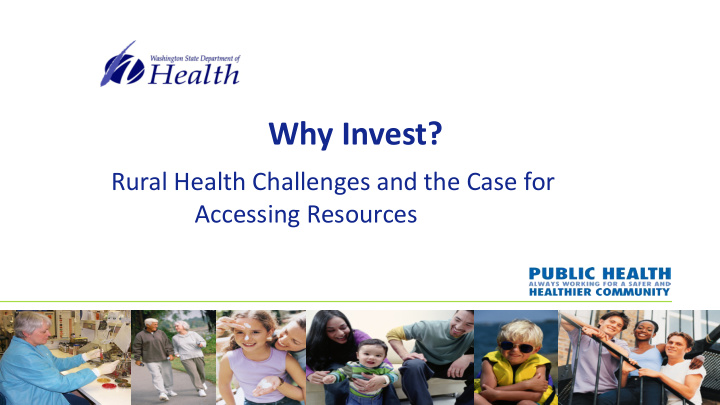



Why Invest? Rural Health Challenges and the Case for Accessing Resources
Objective • Create a common understanding of some key themes for rural health systems in health care transformation. • Link those themes to the importance of the resources discussed today .
Creating a common understanding • Health care systems face the largest challenges and opportunities in the last 75 years (or maybe ever). • Rural health care systems face exponentially tougher challenges and have important strengths.
The transformation; aka the shaky bridge • From volume to value; • From “how many?” to “how did it go?”; • Moving to quality outcomes, incentives to keep a population healthy, and effectively manage illness/injury . • This changes nearly everything.
The challenges: volumes still matter • Decipher the development path from how many visits to how many people. • Work under directly opposing financial incentives. • Develop the new while taking care of patients within thin to nonexistent margins. • No system is perfect ; flaws and challenges uncovered in the new paradigm. • Bring understanding in the community.
The opportunities • Take developmental steps that are neither too slow or too fast . • Redesign mostly “sick care” systems to true health care systems. (While still caring for sick people.) • Remake yourself to decrease outward migration and create stronger links to primary care. • Together with others, build greater health in rural communities.
Defining health “larger” • Attend differently to the 80% of influences on health outside clinical care. • Integration of mental health, chemical dependency and oral health. • Partnerships and networks; moving beyond the walls of the organization, new ties between a broader set of health organizations.
Plain talking “social determinants of health” • Your opportunity for health starts long before you need medical care. • Health begins where we live, learn, work and play. • The opportunity for health begins in our families, neighborhoods, schools and jobs. http://www.rwjf.org/content/dam/farm/reports/reports/2010/rwjf63023
Some of the implications • Define the population as the community, regional service area, market share? • Quality is the new ground for payment, competition and market share. • Hand data pulls take too many resources. • HIT drives effective reporting on measures which drives payment.
The implications • To compete on quality, you need data but you also need the public perception of quality; a challenge in a Hill- Burton era facility. • Workforce challenges are still present; employee experience, recruitment and retention may be linked to up-to-date facilities and technology.
Form follows function and it all follows the money… • The emerging role of hospitals in relationship to primary care, what implications does this have for bricks and morta r? • Wiring up for telehealth/telemedicine is becoming essential. What spaces facilitate optimal use? • To do “health” care, what functional space do you need?
Information push/park/pull • To manage population health, you need networks. • To participate in networks effectively you need 2-way information flow and technology solutions to make that possible.
Technology enables a network
Welcome to a feast of resources that can help you move into the future.
Recommend
More recommend